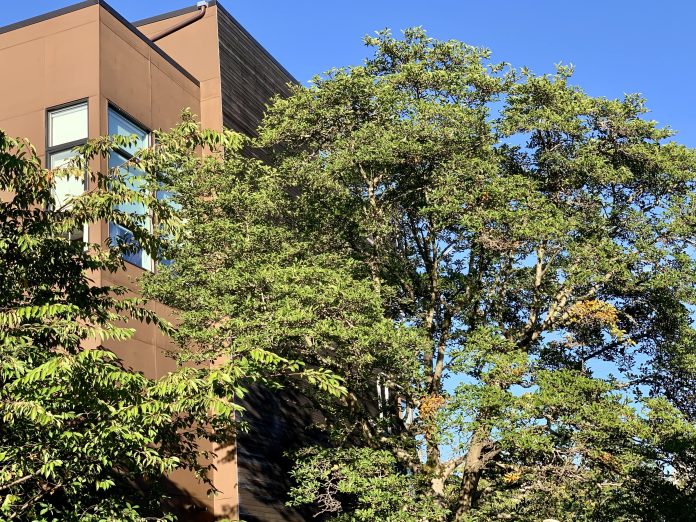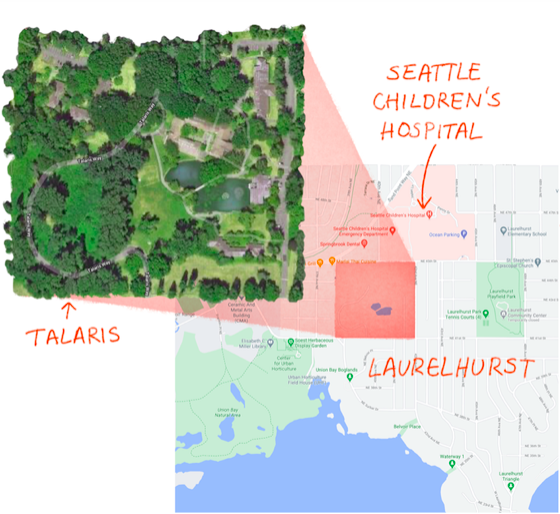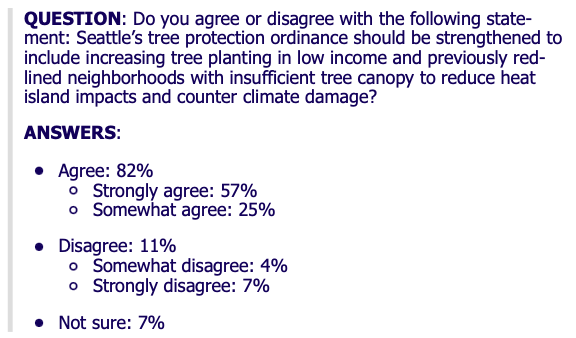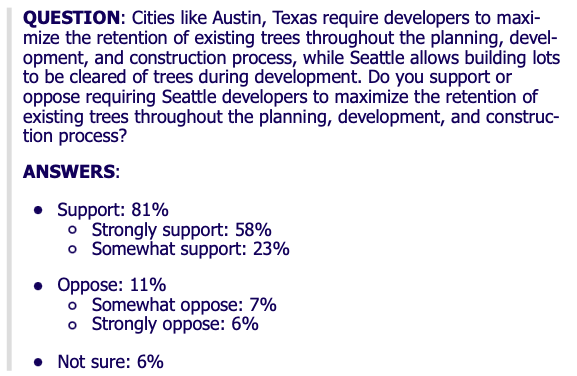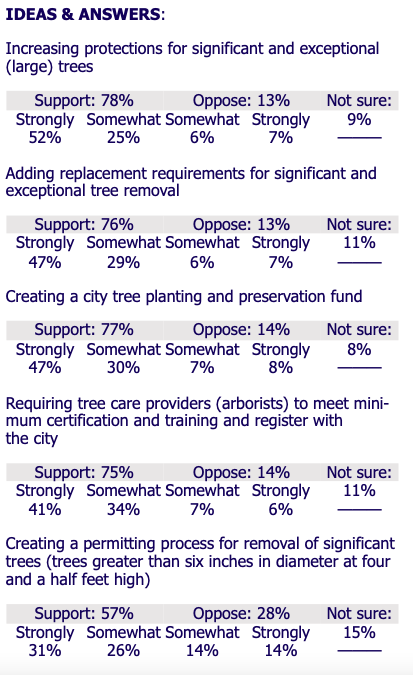This afternoon, City staff will brief the Seattle City Council on tree canopy protections and perhaps finally chart a way forward on a policy area that has long been stalled out, even after a proposal emerged in 2018. The presentation will provide an overview of the City’s Urban Forest Management Plan, which was finalized and published on September 14th, concluding three years of work by staff at the Seattle Department of Construction and Inspections (SDCI) and Office of Sustainability and the Environment (OSE), the Urban Forestry Commission, and other important external stakeholders.
The publication comes on the heels of a recently released poll by the Northwest Progressive Institute (NPI) and TreePAC showing that over three quarters of the 617 participants favored Seattle enacting stronger tree protections, increasing the amount of trees planted in low income and previously redlined neighborhoods, and creating policies that encourage developers to retain existing trees.
This August I reported for The Urbanist in an interview with Weston Brinkley, chair of Urban Forestry Commission, that the City of Seattle has been operating under an interim tree ordinance since 2009 — despite the fact that some experts both in and outside of the city government have the deemed the ordinance to be insufficient. Over the years, local officials have expressed support for passing an updated tree ordinance, but failed to take action.
“Despite more than a decade of promises, Seattle leaders have failed to improve tree protections,” noted Joshua Morris, urban conservation manager for Seattle Audubon in a press release for the NPI poll. “Seattle can densify, prevent sprawl, protect more trees, and plant more new ones. We just have to plan for it. Washington, D.C., for example, continues to increase both population density and tree canopy cover through strong tree protections, dedicated funding, and coordinated urban forestry management. We can learn from their example.”
NPI’s poll indicates Seattle residents would favor adopting policies in line with those in Washington, D.C. or Portland, OR, whose Title 11 tree ordinance was created as an attempt to strike a balance between the city’s tree canopy goals and development goals. Before we move on to the poll’s results, let’s dive into some context around tree removal in Seattle.
Proposed Talaris development represents a flashpoint
The report to Council states Seattle’s urban canopy is made up of more than four million trees, which are valued at close to $5 billion in replacement value. These trees not are only threatened by a lack of tree ordinance protections, climate change is leading to increased harm from drought, disease, and pests. The arrival this summer of sooty bark disease, a deadly fungus which has been identified in 46 of Seattle’s street trees– although it has likely infected far more– may have been exacerbated by warmer summer temperatures.
New development in the city has also negatively impacted the city’s tree canopy, although often in ways that run counter to popular narratives that defend single family zoning under the banner of preserving urban trees. According to Brinkley, new development in many commercial and mixed zoned areas has actually resulted in the planting of new trees because of Seattle Green Factor requirements. These requirements, however, are not in place for single family zoned areas, which has resulted in tree canopy loss as trees are cleared when smaller single family dwellings are replaced with larger ones.
Perhaps the most troubling example of this trend in single family zoned areas is the case of Talaris, a proposed development of 65 large suburban style houses (i.e. McMansions) on the site of an 18-acre former research institute and conference center. The plan, which dubbed by The Urbanist‘s Ray Dubicki as an unmitigated disaster, has generated criticism from both Laurelhurst residents who wish to preserve the historic site and its trees, and housing advocates, like Affordable Talaris, who have expressed shock the city would approve a “cloistered enclave of McMansions at a time of climate, housing, and public health emergency.”
If the Talaris development comes into being as currently envisioned, it will result in the removal of 60% of the trees on the property — a total of two hundred and seventy-one mature trees, one hundred and seventy-five of which are considered exceptional, either by size or as part of a tree grove. The property is current zoned for single family development, meaning its trees are largely unprotected under the current tree protection code, which stipulates that property owners may remove trees if retaining them prevents the development of allowed lot coverage or floor area of the site’s land use. Property owners must show it’s not possible to retain the trees by using various “departures” from the zone’s land use code development standards, but according to Brinkley, the Urban Forestry Commission would like to see more flexibility written into the land use code around items like street setbacks and parking minimums that allow for the preservation of trees.
One last point to add about Talaris is that single family zoning of the site means any new development will not create affordable housing or raise funds through the City’s Mandatory Housing Affordability (MHA) program.
Poll suggests tree protections are popular with Seattle residents
TreePAC, a Seattle group devoted to protecting trees, held a press conference announcing the results of the NPI poll at the Talaris site in order to draw attention to the problems posed by the proposed single family dwelling development.
According to NPI, the tree protection poll elicited “overwhelmingly favorable” responses, that crossed over political fault lines. Overall, 82% of participants agreed that the City should strengthen its tree ordinance to include planting more trees in low income and previously redlined neighborhoods, while 81% of participants supported requiring developers to maximize the retention of existing trees through the planning, development, and construction process.
The poll also asked questions about ideas for significant and exceptional trees protections, all of which also garnered support from a majority of participants. Significant trees are defined as trees with trunks meeting or exceeding six inches in diameter, while exceptional trees are defined by their size, species, condition, cultural/historic importance, age, and/or contribution as part of grove of trees.
It is worth mentioning that the popularity of increasing tree canopy protection is not a simple issue in a growing city like Seattle, and that some of the people who advocate for increasing protections have also supported policies that limit the development of new housing.
One notable example is Councilmember Alex Pedersen (District 4) who noted on his Council blog that “as it has boomed with development, Seattle has struggled to prevent continued loss of significant numbers of large trees and reduced tree canopy area.” Pedersen has tried to position himself as a strong advocate in this area, calling earlier this year for a new tree ordinance to be passed by the middle of 2021 and criticizing colleagues for not supporting his proposal. But he has also been an advocate for preserving parking minimums, which Brinkley has identified has interfering with the preservation of tree canopy, and maintaining single family zoning.
The NPI poll did not ask participants on viewpoints on questions that have often been debated in tandem with tree protection such as single family zoning, but in its presentation of the poll results, the organization did argue that urban density and tree protection can coexist, noting:
Our team at NPI believes that protecting trees is and should be part of every urbanist’s ethos. There is nothing incompatible about protecting trees and building attainable housing, or protecting trees and preventing sprawl. These are priorities we should be pursuing in tandem. Imaginative, responsible, tree-friendly development is what we should want for Seattle.
Northwest Progressive Institute
Urban Forest Management Plan shares updated guiding strategies
While waiting for the passage of an updated tree ordinance, City staff are continuing to revise department strategies regarding tree canopy. The new Urban Forest Management Plan (UFMP) identifies seven strategies, which it connects to specific actions it plans to undertake over the next five years. These include:
- Considering the needs of environmental justice priority communities in all urban forestry actions. UFMP plans to do this by improving access for people in environmental equity priority communities to internships, apprenticeships, and jobs in urban forestry, and also by focusing tree planting and maintenance in these communities as well.
- Identifying and implementing management actions that increase the urban forest’s resilience to potential impacts, including climate change. Conducting a climate change vulnerability assessment to inform how the City’s urban forestry work should respond to a changing climate, including increasing droughts and pests, will be the first step to achieving this work followed by developing a list of resilient tree species and exploring ways to reduce carbon emission from urban forestry work.
- Understanding the condition and complexity of the urban forest resource, how it was different in the past and how it may change in the future. Performing a citywide canopy cover assessment every five years, a major goal for the Urban Forest Commission, will allow the UFMP to compare the results to previous estimates to understand what has changed.
- Coordinating communication, cooperation, and decisions within the City and with other agencies. The Urban Forestry Core Team will continue to take the lead on interdepartmental work. Coordination with other public partners like the federal and state government should be enhanced.
- Inspiring, informing, and working with the community to help care for Seattle’s urban forest. A major initiative the UFMP seeks to undertake is to create a citywide urban forestry communication strategy that will identify better ways to share information with environmental equity communities about volunteer opportunities, tree care information, regulations, incentives, and winter storms. It has expressed that this strategy should have a special emphasis on Native American communities.
- Preserving, restoring, and enhancing the urban forest on City property and rights-of-way. Supporting City efforts to find longterm solutions for homeless encampments in urban forests and exploring solutions for problems presented by tree roots for people with disabilities in the right of way are two action areas identified by the UFMP.
- Providing support to the community, via incentives and regulations, for keeping, removing, replacing, and planting trees. Updates to tree regulations, especially those that pertain to private property (on which 72% of Seattle’s tree canopy is located) is the primary action area related to this strategy.
These strategies take into greater consideration the importance of environmental justice and climate change related to tree canopy preservation; however, without the passage of an updated tree ordinance there will likely be limitations on what these actions can achieve. The question now is whether or not Seattle can move from situation in which the preservation of trees is used to defend current development patterns that encourage sprawl, without meaningfully protecting trees, to one in which thoughtful policy can partner the protection of tree canopy with the growth of denser, more affordable, and more climate-friendly housing and commercial areas.
Natalie Bicknell Argerious (she/her) is a reporter and podcast host at The Urbanist. She previously served as managing editor. A passionate urban explorer since childhood, she loves learning how to make cities more inclusive, vibrant, and environmentally resilient. You can often find her wandering around Seattle's Central District and Capitol Hill with her dogs and cat. Email her at natalie [at] theurbanist [dot] org.


